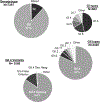Norovirus Outbreaks in Long-term Care Facilities in the United States, 2009-2018: A Decade of Surveillance
- PMID: 34523674
- PMCID: PMC8978331
- DOI: 10.1093/cid/ciab808
Norovirus Outbreaks in Long-term Care Facilities in the United States, 2009-2018: A Decade of Surveillance
Abstract
Background: In the United States, norovirus is the leading cause of healthcare-associated gastroenteritis outbreaks. To inform prevention efforts, we describe the epidemiology of norovirus outbreaks in long-term care facilities (LTCFs).
Methods: The Centers for Disease Control and Prevention (CDC) collect epidemiologic and laboratory data on norovirus outbreaks from US health departments through the National Outbreak Reporting System (NORS) and CaliciNet. Reports from both systems were merged, and norovirus outbreaks in nursing homes, assisted living, and other LTCFs occurring in 2009-2018 were analyzed. Data from the Centers for Medicare and Medicaid Services and the National Center for Health Statistics were used to estimate state LTCF counts.
Results: During 2009-2018, 50 states, Washington D.C., and Puerto Rico reported 13 092 norovirus outbreaks and 416 284 outbreak-associated cases in LTCFs. Participation in NORS and CaliciNet increased from 2009 to 2014 and median reporting of LTCF norovirus outbreaks stabilized at 4.1 outbreaks per 100 LTCFs (interquartile range [IQR]: 1.0-7.1) annually since 2014. Most outbreaks were spread via person-to-person transmission (90.4%), and 75% occurred during December-March. Genogroup was reported for 7292 outbreaks with 862 (11.8%) positive for GI and 6370 (87.3%) for GII. Among 4425 GII outbreaks with typing data, 3618 (81.8%) were GII.4. LTCF residents had higher attack rates than staff (median 29.0% vs 10.9%; P < .001). For every 1000 cases, there were 21.6 hospitalizations and 2.3 deaths.
Conclusions: LTCFs have a high burden of norovirus outbreaks. Most LTCF norovirus outbreaks occurred during winter months and were spread person-to-person. Outbreak surveillance can inform development of interventions for this vulnerable population, such as vaccines targeting GII.4 norovirus strains.
Keywords: long-term care; norovirus; outbreaks; surveillance.
Published by Oxford University Press for the Infectious Diseases Society of America 2021.
Conflict of interest statement
Figures


Similar articles
-
Outbreaks of acute gastroenteritis transmitted by person-to-person contact--United States, 2009-2010.MMWR Surveill Summ. 2012 Dec 14;61(9):1-12. MMWR Surveill Summ. 2012. PMID: 23235338
-
Genotypic and epidemiologic trends of norovirus outbreaks in the United States, 2009 to 2013.J Clin Microbiol. 2014 Jan;52(1):147-55. doi: 10.1128/JCM.02680-13. Epub 2013 Oct 30. J Clin Microbiol. 2014. PMID: 24172151 Free PMC article.
-
Outbreaks of Acute Gastroenteritis Transmitted by Person-to-Person Contact, Environmental Contamination, and Unknown Modes of Transmission--United States, 2009-2013.MMWR Surveill Summ. 2015 Dec 11;64(12):1-16. doi: 10.15585/mmwr.mm6412a1. MMWR Surveill Summ. 2015. PMID: 26656915
-
The epidemiology of published norovirus outbreaks: a review of risk factors associated with attack rate and genogroup.Epidemiol Infect. 2012 Jul;140(7):1161-72. doi: 10.1017/S0950268812000234. Epub 2012 Mar 26. Epidemiol Infect. 2012. PMID: 22444943 Free PMC article. Review.
-
Norovirus outbreaks in China, 2000-2018: A systematic review.Rev Med Virol. 2022 Nov;32(6):e2382. doi: 10.1002/rmv.2382. Epub 2022 Aug 10. Rev Med Virol. 2022. PMID: 35946340 Review.
Cited by
-
Increased circulation of GII.17 noroviruses, six European countries and the United States, 2023 to 2024.Euro Surveill. 2024 Sep;29(39):2400625. doi: 10.2807/1560-7917.ES.2024.29.39.2400625. Euro Surveill. 2024. PMID: 39328162 Free PMC article.
-
Biological and immunological characterization of major capsid protein VP1 from distinct GII.2 norovirus clusters.Sci Rep. 2024 Sep 9;14(1):21035. doi: 10.1038/s41598-024-72062-2. Sci Rep. 2024. PMID: 39251865 Free PMC article.
-
Wastewater-based surveillance as a tool for public health action: SARS-CoV-2 and beyond.Clin Microbiol Rev. 2024 Mar 14;37(1):e0010322. doi: 10.1128/cmr.00103-22. Epub 2023 Dec 14. Clin Microbiol Rev. 2024. PMID: 38095438 Review.
-
An ethical framework adapted for infection prevention and control.Infect Control Hosp Epidemiol. 2023 Dec;44(12):2044-2049. doi: 10.1017/ice.2023.121. Epub 2023 Jul 10. Infect Control Hosp Epidemiol. 2023. PMID: 37424230 Free PMC article.
-
Immunogenicity and Blocking Efficacy of Norovirus GII.4 Recombinant P Protein Vaccine.Vaccines (Basel). 2023 Jun 1;11(6):1053. doi: 10.3390/vaccines11061053. Vaccines (Basel). 2023. PMID: 37376442 Free PMC article.
References
-
- Patel MM, Hall AJ, Vinjé J, Parashar UD. Noroviruses: a comprehensive review. J Clin Virol 2009; 44:1–8. - PubMed
Publication types
MeSH terms
Grants and funding
LinkOut - more resources
Full Text Sources
Medical

